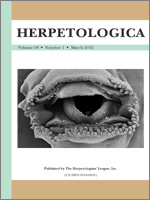Salinization of aquatic habitats is an emerging environmental concern, especially in colder climates where salt is used to prevent road icing during winter months. Salt applied to roads is carried into aquatic environments in storm-water runoff, where fluctuating water levels can result in salt stratification and spatially complex exposure scenarios for embryonic and larval pond-breeding amphibians. We conducted an experiment to investigate the potential interaction between oviposition site selection and toxicity of road salt to embryonic Cope's Gray Treefrogs (Hyla chrysoscelis). We simulated road-salt stratification in 7-L microcosms containing sediment from a salt-contaminated pond and placed developing eggs at three water depths and directly on the sediment of the microcosms. At the beginning of the experiment, conductivity at the bottom of the microcosms was four to seven (from ∼4.0 to 6.5 mS cm−1) times higher than at the top or middle of the water column (∼1.0 mS cm−1). Subsequently, survival of eggs placed near the bottom and on the bottom of buckets containing salt-contaminated sediment was near 0%, while survival of eggs at the top and middle depths of the contaminated microcosms, and at all depths in control microcosms, was >60%. After hatching, embryos avoided the bottom of contaminated buckets even though much of the vertical salt gradient had dissipated. In contrast, embryos in control buckets clustered at the bottom. Our results suggest that pond-breeding amphibians that place their eggs away from the bottom may avoid some of the toxic effects of salt contamination, and those that place eggs on the bottom may be at particularly high risk.
How to translate text using browser tools
1 March 2012
Salt Toxicity to Treefrogs (Hyla Chrysoscelis) Depends on Depth
Emily K. Dobbs,
Maria G. Brown,
Joel W. Snodgrass,
David R. Ownby
ACCESS THE FULL ARTICLE

Herpetologica
Vol. 68 • No. 1
March 2012
Vol. 68 • No. 1
March 2012
Hyla chrysoscelis
road salt
Sodium chloride
Stratification
toxicity




